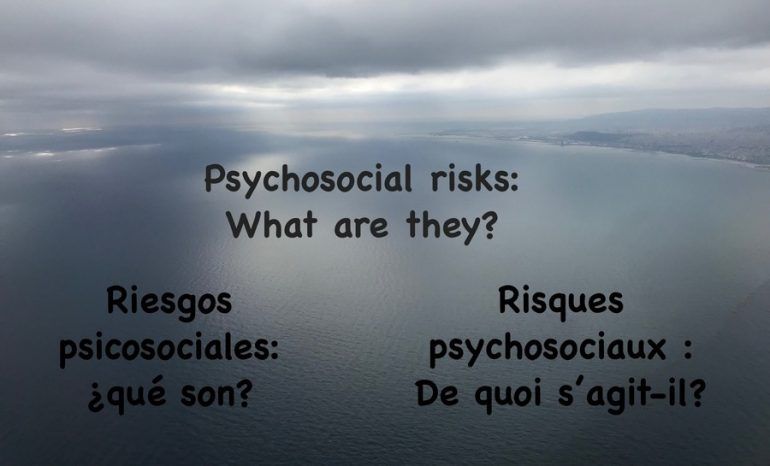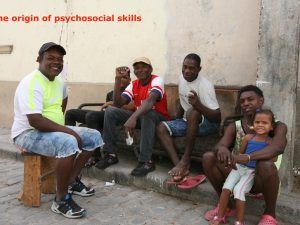- How to tame fear during audits … or any business conflict
- The value of emotional intelligence in compliance audits

The lack of awareness on how to consider psychosocial risks within the audit framework is undeniable. Although corporations are now considering these risks as part of their obligations, little attention is given to this subject by accreditation bodies.

To this day, there is no confirmed approach in the auditing context on how to deal with psychosocial risks, although some countries require an internal health and safety assessment that includes a psychosocial evaluation.
This article explores occupational health and safety risks, as they are perceived in the corporate and auditing world, and shows the two types of psychosocial risks encountered during audits:
- Rational psychosocial risks, covered by ISO 45001 health and safety management audit, which are measurable and traceable.
- Emotional psychosocial risks, also called the ‘wicked problems’, are not measured nor controlled.
What is a psychosocial risk factor?
Psychosocial risks are defined as the “analysis of the management within the social and organizational contexts which tends to cause psychological, social, or physical harm” 1.
Psychosocial risks vary whether they are rational or emotional, leading to different outcomes on businesses and their employees. The risk-analysis is included in the occupational health and safety (or OHS) section of the audit report. This is where rational psychosocial risks are evaluated. However, it is recognized that the OHS standards provide little guidance on how to evaluate psychosocial risks.
1 Cox, T.; Griffiths A. & Rial-González E. 2000. Research on work-related stress. European Agency for safety and health at work.
Understanding the evidence about psychosocial risks

Within the traditional audit approach, OHS risks have to be rigorous, objective, and thereby auditable (Power, 1996).
However, psychosocial risks are not linear nor rigorous; rather, they are subjective and unpredictable, which makes them un-auditable within the traditional audit frame. Because of the difficulties in auditing psychosocial risks, there is a need to develop an audit methodology that can manage the ‘wicked’ side of psychosocial risks.
What are psychosocial risks?
1. Rational psychosocial risks
OHS risk indicators were created to evaluate and trace psychosocial risks within a facility during an audit. The OHSAS 18001 standard provided companies with indicators regarding their internal social risks, as well as their strengths and weaknesses. Some countries require that all companies submit an OHS risk-assessment.
Rational OHS indicators evaluate employees’ safety at a given time, and provide information that can be turned into action.
It is usually measurable, leading to indicators from which a preventive plan can be set. However, not all OHS indicators are traceable: some psychosocial risks are not measurable and therefore require other tools to evaluate, understand and trace them. Let’s begin by describing the current options to measure rational psychosocial risks.
2. How to measure rational psychosocial risks
Three options are suggested to evaluate the rational psychosocial risks within the corporate context, used individually or combined.
i) The ISO 45001 audit permanently replaced the OSHAS 18001 standard on April 1st 2021. It is a third party audit which takes place when a company hires a certification body to perform the audit of its facilities towards certification.

ISO 45001 standard includes questions such as: health and safety management; safety hazard policies and observations; occupational risk management; frequency of safety meetings. However, psychosocial risks are only briefly mentioned in the standard, and the question remains whether audits currently in practice cover these risks to a sufficient extent.
ii) The Publicly Available Specification (PAS 1010) on psychosocial risks was published in 2011, resulting from a collaboration between the British Standards Institution (BSI), the Institute of Work Health and Organizations (I-WHO), and the University of Nottingham, GB.
At the time, the goal of this document was to develop remedies to the shortcomings of the OHSAS standard because it was clear that work-related stress was not defined nor addressed during audits. The field of psychosocial risks includes moral and physical violence, psychological harassment, bullying, work-related stress: they are difficult to evaluate and often require individual attention. The European Foundation for the improvement of living and working conditions carry out surveys on regular basis throughout the 26 countries, to evaluate work-related policies.
iii) Internal interviews or questionnaires anonymously filled by all employees and analyzed to provide valuable inside information.
These three risk-evaluations methods help occupational health and safety management find the adequate solutions to traceable and measurable problems.
3. The emotional psychosocial risks
Unlike rational OHS risks, emotional risks are mostly determined by the way in which people perceive risks they are exposed to. The perception is subjective because it affects people differently. Stress-related issues may cause distress in one individual and none in another. However, unlike rational OHS risks, emotional risks are often imperceptible and they are hard to evaluate because they are not necessarily measurable.


Although their onset affect employees’ performance, it is not always easy to find the root cause of the discomfort or dissatisfaction at work.
Over time, these particular psychosocial risks have been called wicked problems because of the difficulty in finding evidence and solutions to solve them. The well-known wicked problem that affects current working environment is the ‘burn-out syndrome’, a combination of physical and psychological breakdowns that result in exhaustion and affecting workers in all industries and countries.
4. What is a ‘wicked problem’?
The term ‘wicked problem’ is defined by two Australian researchers as “problems in society that are marked by unclear cause-and-effect relationships as well as complexity, uncertainty, and ambiguity in the problem-solving process”.
Consequently, to ease the approach toward intangible issues, the authors put together a list of ten characteristics that define ‘wicked problems’:
1. There is no definitive formulation of a wicked problem.
2. Wicked problems have no ‘stopping rule’, thus no definitive solution.

3. Solutions to wicked problems are not true-or-false, but good-or-bad.
4. There is no immediate and no ultimate test of a solution to a wicked problem.
5. Every (attempted) solution to a wicked problem is a ‘one-shot operation’; the results cannot be readily undone, and there is no opportunity to learn by trial-and-error.
6. Wicked problems do not have an enumerable (or an exhaustively describable) set of potential solutions, nor is there a well-described set of permissible operations that may be incorporated into the plan.
7. Every wicked problem is essentially unique.
8. Every wicked problem can be considered to be a symptom of another problem.
9. The existence of a discrepancy representing a wicked problem can be explained in numerous ways.
10. The planner has no ‘right to be wrong’; there is no public tolerance of experiments that fail.

These ‘wicked problem’ characteristics show the complexity of emotional behaviors. There are no indicators to understand the challenges involved in managing emotional psychosocial risks. Therefore, the search for solutions to address them is far from over.
5. How to measure emotional psychosocial risks
Although this area is difficult to evaluate without measurables, here are three approaches to manage emotional psychosocial risks within an organization:
- In their empirical study, three authors suggest carrying out an internal emotional psychosocial risk-evaluation to assess the needs. This is usually done through individual interviews or questionnaires while respecting employees’ confidentiality. The workforce assessment provides evidence that may be integrated into the company’s risk management process.
- The PhD thesis of a Danish scholar offers a thorough analysis of psychosocial risk management where she suggests that the auditor’s competencies are the core element when dealing with such delicate matters within an audited organization.
- In my article about emotional intelligence, I suggest that the control of emotional risks within the auditing context starts with self-awareness. Emotional intelligence is a skill and therefore can be learned and measured; therefore, it is up to certification bodies to train their auditors with the knowledge needed to distinguish and address emotional psychosocial risks during an audit.
Emotional psychosocial risks are understood as complex, with multi-causal effects that go beyond the occupational health and safety measures in place. The difficulty lies in the evaluation process used to assess them because it does not consider wicked problems, “characterized by unclear cause-effect relationships and uncertain solutions”.
The evaluation of rational and emotional psychosocial risks, and their consequences on the workforce, cannot be objectively solved with a sole technical approach.

Emotional psychosocial risk-evaluations must go beyond the measurable results of an audit standard to understand the psychosocial stressors: they require one-on-one interviews with employees to assess the gaps in abilities to manage complex psychosocial working environments. Once the auditor has the competencies to understand a company’s rational and emotional psychosocial risks, a complete psychosocial evaluation can be carried out.
One of the challenges to reach this goal is to transform “audit principles into audit practices”; suggestions will be presented in upcoming articles on IMAGO.AUDITING.
Thank you!
Check IMAGO.AUDITING and its new website www.imago-int.eu. Stay connected and receive upcoming newsletters with updates on articles, the blog and webinars. Subscribe at info@imago-int.eu.
About Oliver
Related Articles
3 Comments
Pingbacks
[…] my recent article about psychosocial risks, I describe risk factors and divide them into two categories: the rational risks and the emotional […]
- Le chemin qui mène aux compétences psychosociales et la prévention des risques psychosociaux | IMAGO 3 years ago
[…] my recent article about psychosocial risks, I describe risk factors and divide them into two categories: the rational risks and the emotional […]
- The origin of psychosocial skills – IMAGO 3 years ago
[…] my recent article about psychosocial risks, I describe risk factors and divide them into two categories: the rational risks and the emotional […]
Leave a reply Click here to cancel the reply
You must be logged in to post a comment.





